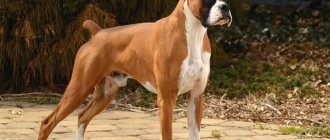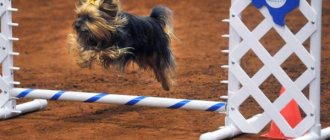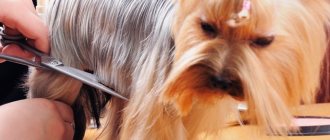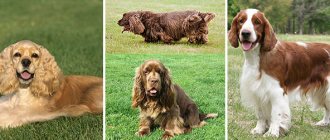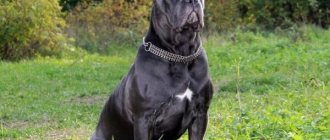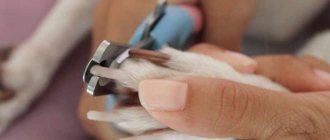Ear cropping helps prevent injuries to dogs: if a dog has short ears, then he is less vulnerable in a fight with an enemy. From century to century, guard and fighting breeds have been subjected to this procedure, but today it serves more of an aesthetic purpose. A beautiful head shape is formed according to standards. After cropping, the ears always stand up, so the dog has a serious, menacing appearance. There are also medical reasons for the operation - some breeds simply need docking.
Staffordshire Terrier
Many owners believe that cropped Staff ears look much better than natural ones. After the procedure, the dog's face becomes very cute.
There is also a medical reason for docking - this breed often suffers from infections of the external auditory canals. To prevent the disease from developing, the Staffordshire Terrier's ears are cropped. It is recommended to do this at the age of 1.5-3 months, then there will be no unnecessary blood loss and pain.
If the ears do not occupy a vertical position after surgery, they are wrapped and supported in a certain way. There are several options for the standard shapes of docked ears specifically for the Staff: fighting (the shortest), short, show and long.
Why dock tails and ears: arguments for and against
There are about 50 breeds in the world that have traditionally been docked for several centuries. Their appearance with long tails and ears is at least unusual and not always justified, supporters of docking believe. But for each of their arguments, opponents have their own arguments.
Surgeries on newborns: cruelty or humanism? Tail docking is carried out in the first days of life and many veterinarians are confident that tail surgery at such an early age on still fragile caudal vertebrae is practically painless. Babies who are docked while sleeping sometimes don’t even wake up. After the procedure, they immediately return to their mother with an excellent appetite. There is no evidence that growth or development is delayed by the procedure. But if tail damage occurs in adulthood and amputation is required for therapeutic reasons, the healing process can be painful and protracted.
Tail docking for puppies is carried out at the age of several days.
The fact that puppies usually whine much louder during surgery and go silent on average 15 minutes afterward indicates pain sensitivity. There is a question about the negative impact of a tail nerve injury in later life, the appearance of “phantom pain”. Because puppies' brains are still developing, a trauma of this magnitude can affect "the final architecture of the dog's pain system." All these are just hypotheses, but very logical and convincing. It is impossible to assess the level of stress and other negative effects of tail trimming in puppies. Single data from owners of docked dogs about changes in behavior do not allow us to draw an objective picture.
Damage. Working herding and hunting breeds often have to run through dense vegetation, where they usually get injured, less often when encountering wild animals. These injuries are very painful and difficult to treat. Very energetic dogs can damage their tails, even against walls at home. Opponents may say that there is no data confirming a significant difference in the number of tail injuries, but in response they are given the example of Switzerland, where tail trimming was banned in 1989. In the same year, they began monitoring puppies from 50 litters of Shorthaired Pointers. 38% suffered tail injuries before they were 18 months old. By 1991, the number of dogs had increased to 51%.
The first country to ban docking was Switzerland: 1981 (ears), 1988 (tails)
For reasons of hygiene. Long-haired breeds have their tails docked to prevent feces from constantly contaminating the fur around the anus. And while domestic dogs can still be washed and trimmed regularly, caring for the tails of yard dogs is complicated for obvious reasons.
Prick ears are natural. There are no dogs in nature with hanging long ears. Such dogs require more care, regular cleaning and are susceptible to developing otitis media. Cupping facilitates hygiene and improves hearing, and also plays a significant role in the prevention of ear diseases. Opponents are confident that sanitary and hygienic arguments are not credible because they do not have sufficient scientific justification.
Communication. Robert Waynesborough published a paper in 1996 in which he argued that dogs with short tails have a harder time communicating with their peers using body language signals. In 2007, his work was supported by Stephen Leaver, who found that tail length is important for transmitting social signals, including in relation to humans. Dogs with docked tails are treated with greater caution by their relatives. In response to this, the owner of the canine organization American Guardian K9, Lee Robinson, argues that such reports have no evidence and are supported mainly by animal rights activists who have no experience interacting with working dogs.
A striking example of communication using the tail in dogs
Benefit or harm. On the one hand, shortening the tail and ears does not have a negative effect on health, but their benefits are questionable. It is difficult to disagree that in most cases such cosmetic procedures are the whim of the owner. For dogs it is useless and also painful. And the arguments about the menacing appearance are ridiculous and untenable. Opponents also say that amputation of the tail up to 1-2 vertebrae can cause the development of incontinence. Research on this topic has been conducted by veterinarians in Australia and the United States, but the results are mixed.
Preservation of breed characteristics. In some breeds, most dogs are natural bobtails (Corgi, Old English Sheepdog, French Bulldog, Australian Shepherd), but not all. It is not uncommon for puppies to be born with tails of different lengths. Docking allows you to fit dogs to a single standard. Who would believe that a corgi has a tail? The procedure also allowed owners to avoid disqualification and withdrawal from breeding if there were kinks or knots in the tail that could no longer be identified.
Doberman
It was not nature that gave the Doberman long pointed ears; removing the loose soft part helps give them the desired shape. The standard provides for such an operation to obtain an invulnerable service dog. This is what the creator of the breed, Louis Doberman, wanted.
The procedure simplifies the care of the pet, makes it more intimidating, and eliminates the risk of injury in service. Ear cropping protects against rabies and reduces the risk of ear inflammation.
The optimal age of a puppy for surgery is 6-7 weeks. Approximately 2/5 of the shell area is cut off, taking into account the size of the head to achieve harmony. Correct ear position is guaranteed by bandages and clamps.
From the history of cupping
Cropping dogs' tails and ears is a practice that has been used for centuries to prevent damage, for hygienic and other reasons. The first known records of such operations date back to the 5th century BC. e. In them, the traveler Timako from the Greek city of Pylos talks about Ancient Rome and mentions that dogs there have their tails cut off, believing that this will protect against rabies (“jackal disease”). In ancient times it was also believed that it strengthened the back, increased speed and endurance. Fighting dogs must be docked to reduce the risk of injury.
A little later, ears and tails were traditionally trimmed for hunting and herding dogs, which often encounter wild animals. This was not done for beauty, but to reduce the risk of bites, bleeding, infection, bruises and other health problems.
The spread of the practice was significantly influenced by a law in force in England in the 17th century, which exempted owners of service dogs from taxes. The indicator of “service” was a trimmed tail. To avoid tax liability, everyone began to have their tails cut off, even greyhounds. This was a legal way to prove that the dog was not a hunting dog and its owner was not a poacher. In 1896, the law was repealed, but the tradition remained.
At the end of the 19th and beginning of the 20th centuries, many working breeds, including fighting ones, began to smoothly transition into the category of companions. Cupping was carried out for aesthetic reasons or because it was prescribed in the standard and was one of the conditions for successful participation in exhibitions. Since the mid-20th century, animal rights activists began to actively oppose cosmetic surgery (unjustified mutilation). Currently, operations to change appearance without medical indications are prohibited in many countries, and breed standards have been revised.
Spaniel owners began docking their pets' tails around the 16th century. This was done for practical reasons. When chasing prey in thickets of bushes, dogs often beat their tails until they bleed.
Doberman Pinscher
Many people consider the Pinscher to be cruel and aggressive. But this is a beautiful and noble breed, practically no different from the Doberman. According to owners, ear cropping gives the dog a special charm. Vulnerability in combat is not so relevant today. The operation pursues decorative and hygienic purposes. The dog becomes better protected from wounds, necrosis and neoplasms.
The procedure is carried out 3-10 days after the puppy is born. 3/5 of the original length remains. An adult Doberman Pinscher's ears point straight up and forward.
How does this happen
The procedure is simple and no special preparation is required. It does not last long and consists of several stages:
- a painkiller is administered, calculated according to the dog’s weight;
- the skin on the tail is moved as close as possible to its base. This is done necessarily, because after circumcision the skin will move into place and close the wound. If there is not enough skin, the stump will take a long time to heal, and hair will not grow at the end of the tail in the future;
- A bandage tourniquet is applied at the base to reduce bleeding;
- circumcision is carried out with scissors or a scalpel;
- the wound is treated with an antiseptic;
- the tourniquet is removed so that the skin moves into place, and then the tourniquet is tied again;
- for puppies after 10 days, a suture is placed at the end of the docked tail; younger puppies do not need to do this, the wound quickly heals on its own;
- the tourniquet is removed.
It is important to ensure that the mother does not lick the tails of her puppies for some time after the operation.
The threads are removed from the seam after 4-5 days, sometimes earlier.
Great Dane
For this breed, the patterns are by no means short. The Great Dane's ear is cut off by 1.5-3 cm. The operation is performed on the puppy at 2.5-4 months. A later procedure threatens the appearance of soft cartilage, low posture and creases. A bandage and clamps will come in handy.
The breed standard stipulates mandatory ear cropping for Great Danes for aesthetic purposes; medical indications are secondary here.
Cost, where can cupping be done
In all EU countries, docking is strictly prohibited. Operations here are carried out only illegally at home. In Russia, docking can be done both at home and in specialized veterinary hospitals. Due to the complexity of the operations and the difficult rehabilitation period, veterinarians do not recommend performing operations at home, as this can lead to serious complications for the dog.
The cost of the procedure for the ears is 500 rubles, cutting off the tail will cost from 2,000 to 4,000 rubles.*
Schnauzers
The German tradition in relation to wire-haired schnauzers has always rejected lack of composure, promoted harmony and balance, and affirmed a clearly defined silhouette of the head and a “brick-shaped” muzzle. Ear cropping helped achieve such standards.
The correct operation creates an image chopped with an ax and gives a stern and wary appearance to this service breed. The procedure is carried out until the child reaches one year of age. After docking, the ears must be exposed.
Boxers
There are no such dogs with floppy ears in nature. Docking for a boxer is not a whim, but a vital necessity.
This breed can have ears of different shapes and sizes. The situation is the same with thickness and density, positioning and turning. In any case, the ears should be in harmony with the Boxer's head.
The best age for surgery is 2.5-3.5 months. The standard provides for a sharp shape of the ears.
Caucasian Shepherd Dog
This breed was created for protection. The operation is performed to protect the dog from infection if the animal is injured. Ear cropping is also necessary to create the dog’s characteristic appearance.
From the age of 3 months, puppies fight for territory and leadership. By six months, only rags remain from the auricle. When the puppy is strong enough, he is docked. There are no uniform patterns, because each animal has an individual head shape and ear structure. As a rule, the top part is cut off.
Are these procedures legal?
Tail docking and ear cropping procedures are illegal in many countries around the world, including Australia and several European countries.
In the United States, ear cropping and tail docking remain legal procedures in most cases, although some states have regulations regarding the timing of the surgery and the need for anesthesia during the process. Maryland and Pennsylvania are the only states that have provisions restricting tail docking, and nine states have measures to regulate ear cropping.
Found a violation? Report content
Central asian shepherd dog
This is an ancient working breed with deep traditions. Dogs have a peculiar shape of ears, which are trimmed in the first days of a puppy's life. Then you don’t have to put stitches, and the wounds heal quickly.
The Central Asian Shepherd used to herd herds and fight predators. Her ears are her weak spot. When wounded, an adult Alabai loses a lot of blood, so shepherds always shortened the ears of puppies.
According to the standard, half of the cartilage remains, and the cut is semicircular or straight. “Caucasian” is the shortest form, “bear” is very popular, with it puppies look like funny bear cubs.
Postoperative care
If the dog tends to lick the tail, a veterinary collar is put on it. If the tail remains painful for a long time or has purulent inflammation, contact a veterinarian.
After ear trimming surgery, the dog can be fed a small portion of liquid food. If the puppy is in severe pain, give a painkiller based on its weight.
To avoid scratching the cut, the animal is put on a veterinary collar. The dog will be able to eat and sleep freely in it at home.
Ear care involves treating the cut with a solution of chlorhexidine or dioxidine. Treatment is carried out 2-3 times a day for a week. To do this, the solution is applied using a pipette or a cotton swab from top to bottom. In this case, the movements should be pressing so as not to cause pain.
If crusts form on the incision, they are treated with Levosin ointment (blotting movements). This ointment relieves pain, relieves itching and speeds up the healing process.
You can go outside after 2-3 days if the weather is dry. After the walk, the ears are treated.
You can remove crusts using hydrogen peroxide. A gauze cloth is generously moistened with peroxide and applied to the ear for 5 minutes. Soaked crusts are carefully removed.
The sutures disintegrate after two weeks. The remaining threads are carefully removed using sterile scissors.
The ears of some dog breeds (eg Doberman, Boxer) require additional support to support them in a standing position. To do this, a rigid frame is made that supports the ear membrane in a taut vertical position.
The frame is installed one day after surgery and worn continuously for 3-4 weeks. Every 4 days, the adhesive plaster is replaced with a new one, and the ear is secured to the frame. The subtleties of gluing and setting the ears will be learned from the puppy's breeder.
Pit bull terrier
The breed was bred for dog fighting. Today this is a rare occurrence, and the strongly built animals live in peace with humans.
Puppies are docked at the age of 1-2 weeks, usually leaving 1/3 of the original length of the ear. The fighting form has short shells, the exhibition form is very characteristic, with a corner bent inward.
The operation prevents ear necrosis, ulcers, injuries and neoplasms in pit bulls.
Cane Corso
Owners of dogs of this breed cannot imagine a Cane Corso with floppy ears. Such a dog would look ridiculous and funny, and all royal nobility would disappear. Puppies with uncropped ears may not be purchased at all.
The ears of this breed are trimmed in a triangle. The dog immediately becomes majestic and menacing. After surgery, the animal needs care. The cartilages are glued with adhesive for proper alignment.
Refusing docking for humanitarian reasons is not the best solution. If you feel sorry for your pet now, you may feel sorry for him more than once when he hurts his ears in a fight or gets sick. If the breed standards provide for such an operation, then it must be carried out.
